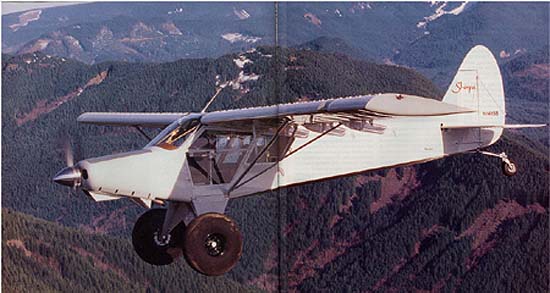
Sherpa

PAGE THREE
I was feeling like a bush pilot until we dropped down into a canyon and started buzzing along right over a serpentine river 1,000 feet below the rim. We did our eagle routine and twisted and turned right along with the river. As we did, Byron was pointing out gravel bars and small spaces along the bank they used as landing spots while fishing. That's when I knew I was no bush pilot and why Byron was so willing to let me flop around in the mud on top the mesa...the spots he was pointing out weren't large enough or smooth enough to orchestrate a crash, much less a landing. At least that's what I thought. Just to prove a point, Byron pointed out a small speck of gravel sticking out of the water and said that was a good spot for steelhead fishing. He ran out all the flaps, pulled up over a rock ledge sticking out of the side of the canyon, floated around in a tight turn and dropped down close to the surface of the water. From the back seat, I never saw the gravel bar until our big baloney tires crunched onto it at the edge of the water. We bounded along over the incredibly rough surface for less than half the length of the gravel bar. I paced off our landing roll as 110 feet. We were two people, 85 gallons of gas, 65° F and 3,500 ft MSL. I had trouble pacing off the distance because the surface was comprised entirely of water-worn rocks the size of cantaloupes and I was afraid I was going to break an ankle! This was the kind of surface that, according to Byron, eats stock Super Cub structure and it was easy to see why. Even with fat tires, the Cub's structure just wasn't designed for those kinds of loads, especially around the tail post. Byron also says fully loaded to 4,750 pounds (2,200 pounds usable) the airplane will still get into or out of anywhere you'd dream of putting a Super Cub and loaded to lower weights can go places you wouldn't dare take a stock Super Cub. In most situations it will even out fly his big engine Cub.
Undoubtedly the most impressive part about the airplane is the ease with which a pilot could learn to handle it in the bush environment. The controls are very normal feeling, meaning neither light nor heavy and the airplane responds surprisingly quickly for an airplane that size. They have a number of aerodynamic changes in the works to be completed before certification which include a longer tail moment to take care of the reduced tail efficiency at full flap extension and a larger wing with more flap. Their aerodynamicist says they will trim another 6 knots off the stall speed with the new wing. Considering they have radared the airplane as flying 34 mph (power-on), a 6 knot speed reduction would make the airplane even easier to get in and out. In fact it would be the next best thing to a helicopter, which it is already. Byron says their goal is an airplane that can get off in less than 100 feet, zero wind with 500 pounds on board. As it is, with a ten mph wind they can do that in 72 feet! It's this last point, the comparing of the airplane's utility with that of a helicopter, that continually bounced through my mind during the day. With the possible exception of landing on roof tops and tennis courts, the Sherpa could do probably 80% of what a helicopter does with a fraction of the purchase and maintenance cost and with much less chance of equipment breakage in the field. When we were enroute back to home base I noticed a curious change had taken place in my mind. I found myself thinking like I used to when flying a Super Cub on skis after a major snow storm. In that situation, with skis and lots of snow, everything flat is a runway. You can land everywhere. On the way back with the Sherpa, I'd look down and see a small flat spot and think, "...we can land in that easy..." It was a very comforting feeling. And when I saw a small remote town without a runway, I realized it didn't need a runway for emergency medivac situations. There were a dozen flat spots within city limits where the Sherpa could land with no sweat. A football field becomes an airport...literally! The Sherpa is also faster than all but the most exotic choppers. We were showing 120 knots, which at that altitude and temperature was a shade over 140 knots true. Incidentally, while we were cruising along at altitude, the visibility in all directions was amazing. The nose is way, way down and the glass doors let you look straight down. Byron said the fish and wild life boys who were evaluating the airplane would go for the standard 29 x 11 x 10 tires because they wouldn't block as much of their view. He also said they were working on a curtain/shade for over the pilot's head because he is out in the Plexiglas and gets pretty hot. Ignoring the airplane's ability to work in the bush, I'd be very surprised if government agencies, both ours and other country's, didn't jump on this bird as one which could replace helicopters and other fixed wing airplanes for a lot of use where ultra-short runways aren't even a factor. At 45 knots it is slow enough to do bird counts, pipeline patrol, border surveillance and on and on. It is also an airplane almost anyone can fly easily since its ground handling is so benign. I think these guys are really onto something! |